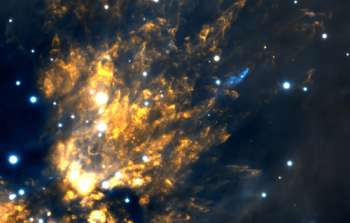sci15020 — Announcement
New Clarity and Change in an Explosive Stellar Outflow
March 18, 2015
The outflow of the “Orion Fingers” is evident in this high-resolution image from Bally et al. (2015). The leading fingertips appear in [Fe II] (cyan), and the trailing fingers are evident in molecular hydrogen emission (orange). Comparison with earlier observations shows the motion and morphological changes of the emitting knots.
The outflow that emerges from the Orion Molecular Cloud 1 (OMC1) offers a rare opportunity to observe a catastrophic episode in a massive star-forming region. The large scale of the outflow and the common dynamical age of the many moving knots in the region known as the “Orion Fingers,” point to an explosive origin. New observations using the Gemini Multi-conjugate Adaptive Optics System (GeMS), and the Gemini South Adaptive Optics Imager (GSAOI), provide the sharpest views ever obtained of the large region, nearly reaching the diffraction limit with resolutions between 0.08 to 0.1 arcseconds.
John Bally (University of Colorado) and collaborators directly measure the motion of specific fingers in the outflow and their morphological changes. They suggest that stellar merger events could produce such outflows, which would also trigger the runaway of massive stars from their birthplaces. Brief information is posted at the Gemini website. A preprint is now available, and full results will be published in Astronomy and Astrophysics.
Contacts
About the Announcement
| Id: |
ID
sci15020
|
